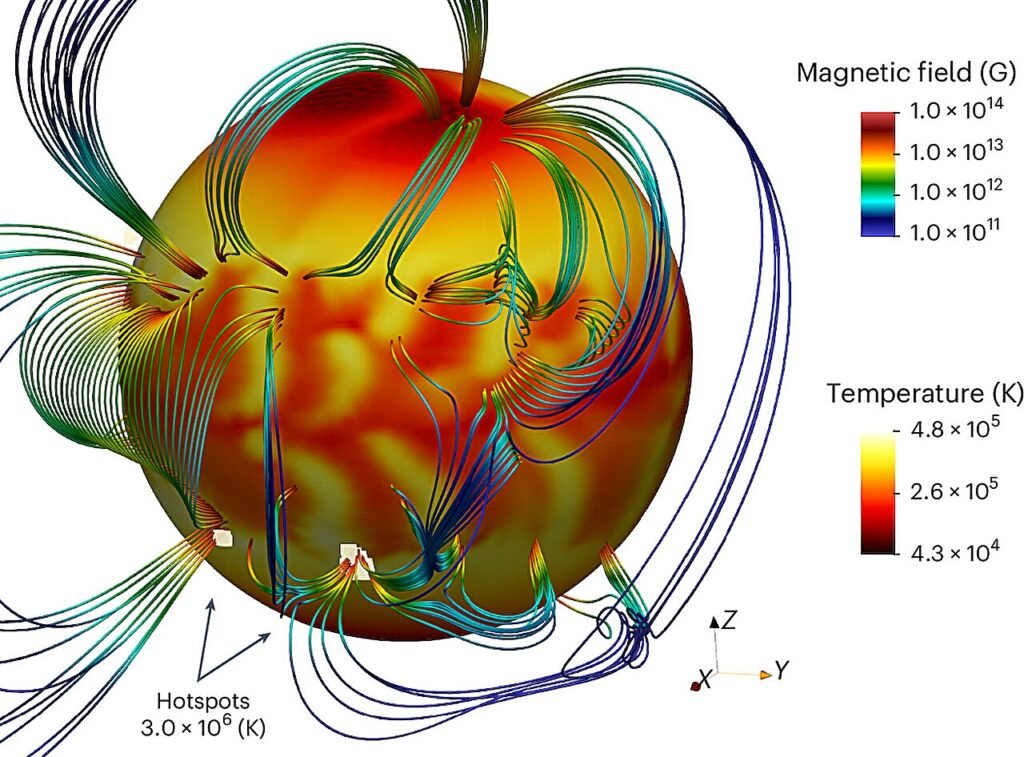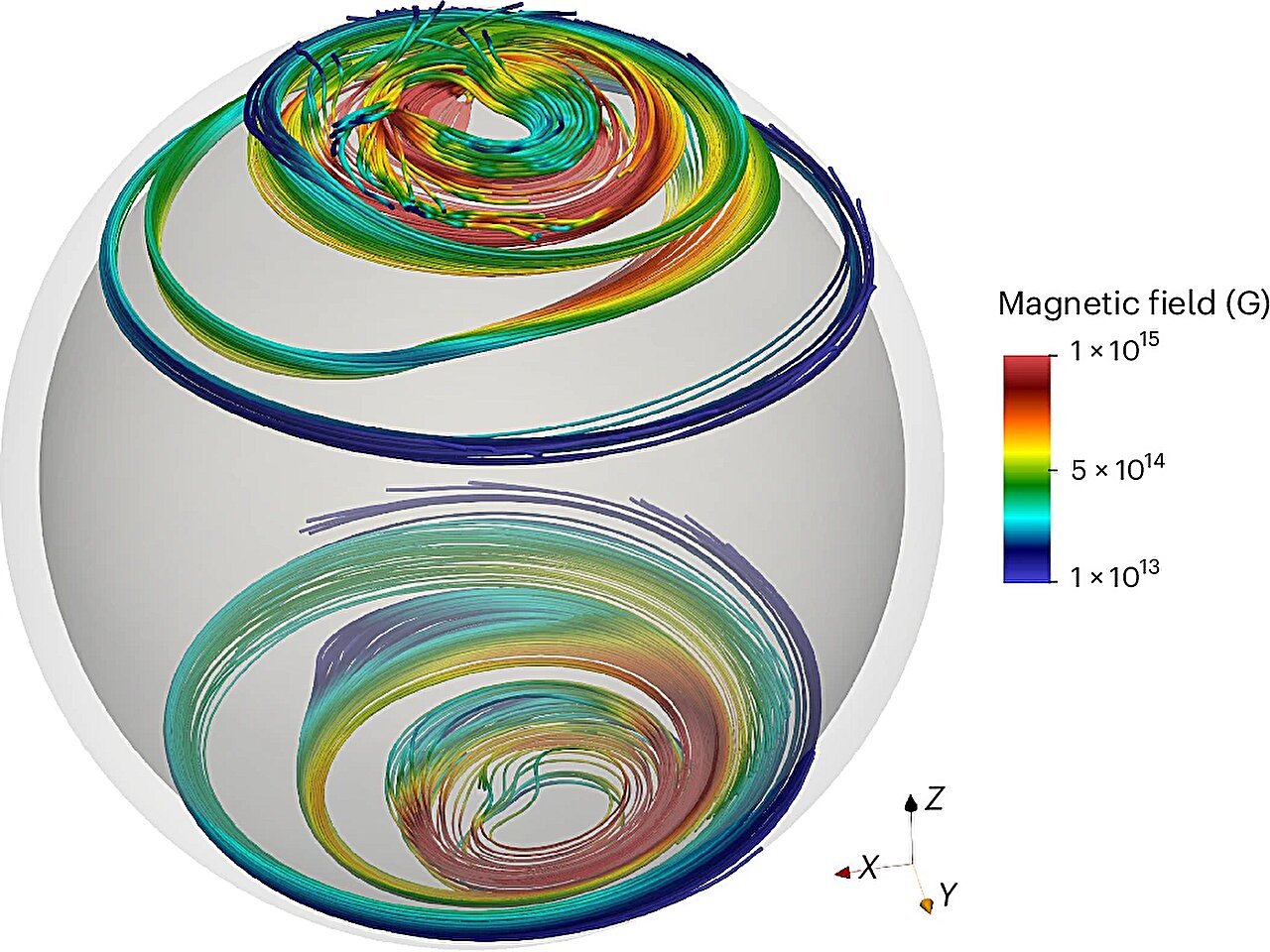An international team of scientists has made significant strides in understanding the formation and evolution of some of the universe’s most powerful and enigmatic magnetic fields. Led by researchers from Newcastle University, University of Leeds, and institutions in France, their findings, published in the esteemed journal Nature Astronomy, address a long-standing mystery surrounding the creation of low-field magnetars—an unusual type of neutron star with relatively weaker magnetic fields compared to their more commonly known counterparts.
Since the discovery of low-field magnetars in 2010, scientists have struggled to explain how these stars, which emit intense X-ray radiation, develop magnetic fields significantly weaker than their highly magnetized counterparts, known as high-field magnetars. The new research provides a solution by identifying a dynamo mechanism driven by the fall-back of supernova material as the key process behind their formation.
The Role of the Tayler-Spruit Dynamo Mechanism
The team’s research centers on the Tayler-Spruit dynamo, a theoretical mechanism proposed nearly 25 years ago, which plays a crucial role in the creation of these weaker magnetic fields. The Tayler-Spruit dynamo suggests that the fall-back material from a supernova explosion, which contains a mix of gas and debris from the outer layers of the progenitor star, can trigger a specific dynamo process within the proto-neutron star. This process not only drives the star’s rotation but also helps shape its magnetic field, resulting in the creation of a low-field magnetar.
To investigate this, the researchers employed advanced numerical simulations to model the magneto-thermal evolution of neutron stars. These simulations provided the most detailed picture yet of how this dynamo operates, especially in the extreme environments of a collapsing star. The team found that during the fall-back process, the material from the supernova collapses inward, causing the neutron star to rotate rapidly. This rapid rotation, in turn, leads to the generation of complex magnetic fields inside the star, which are much stronger than the magnetic fields on its outer surface.

Magnetars: The Unusual Neutron Stars
Magnetars, a type of neutron star, are some of the most extreme objects in the universe. Known for their extraordinary magnetic fields, which are hundreds of trillions of times stronger than the Earth’s magnetic field, these stars emit intense radiation, primarily in the X-ray and gamma-ray wavelengths. Due to their extreme magnetic fields, magnetars are not only some of the most energetic objects in the universe but also highly unstable, with variable emissions and powerful bursts of energy.
While most magnetars are extremely magnetized, some exhibit much weaker magnetic fields. These weaker magnetars are classified as low-field magnetars, and their properties have remained an enigma since their discovery over a decade ago. The new findings help explain the formation of these low-field magnetars by revealing how specific dynamo processes can generate weaker magnetic fields within a collapsing neutron star.
The Significance of the Discovery
This breakthrough in understanding low-field magnetars is a major step in resolving a puzzle that has confounded scientists for years. The discovery of the Tayler-Spruit dynamo as a driving force behind the formation of these weakly magnetized neutron stars helps clarify the nature of magnetic field formation in extreme environments, where traditional theories could not provide satisfactory explanations. Additionally, it underscores the importance of supernova fall-back in shaping the properties of the resulting neutron star.
Dr. Andrei Igoshev, the lead author of the study and a Research Fellow at Newcastle University’s School of Mathematics, Statistics, and Physics, explained that the fall-back material from a supernova explosion plays a pivotal role in the formation of magnetic fields via the Tayler-Spruit dynamo mechanism. He noted that while the dynamo mechanism was proposed in theory nearly a quarter of a century ago, it was only recently that computer simulations could reproduce the complex behavior of the magnetic field generation within the star. He emphasized that the magnetic fields formed by this mechanism are not simple but rather highly intricate, with much stronger internal magnetic fields than those seen on the surface.
Dr. Igoshev’s comments highlight the complexity of neutron star magnetic fields and underscore the novelty of their work in modeling such a dynamic and intricate process. The results not only shed light on low-field magnetars but also offer insights into the broader behavior of neutron star magnetic fields, which have been notoriously difficult to study due to their extreme conditions.
Implications for Future Research
The findings from this study open the door to further exploration of the complex magnetic fields that govern the behavior of neutron stars. Dr. Igoshev, who is establishing a new research group at Newcastle University to continue investigating these phenomena, aims to deepen our understanding of neutron stars and their magnetic properties. This research is expected to have profound implications for astrophysics, particularly in understanding how magnetic fields affect the evolution and behavior of compact stellar remnants.
One of the most exciting aspects of this work is its potential to refine models of supernova explosions and their aftermath. By gaining a better understanding of how material falls back onto a neutron star, scientists may be able to enhance our knowledge of how stars end their lives, and how those final stages shape the stars’ ultimate characteristics. Additionally, these insights could contribute to a broader understanding of how extreme magnetic environments, such as those present in magnetars, influence the behavior of matter and radiation.
Conclusion
This research represents a significant milestone in our understanding of the formation of low-field magnetars and the dynamo mechanisms that shape the magnetic fields of neutron stars. By using cutting-edge simulations and drawing on decades of theoretical work, the team has managed to solve a long-standing mystery in astrophysics. As we continue to explore the complexities of the universe, studies like this bring us closer to unraveling the behaviors of some of the most extreme objects in space, with far-reaching implications for our understanding of the cosmos.
With Dr. Igoshev’s new research group at Newcastle University, further investigations into these fascinating objects are sure to yield more groundbreaking discoveries in the years to come, potentially expanding our knowledge of magnetars, neutron stars, and the universe itself.
Reference: Andrei Igoshev et al, A connection between proto-neutron-star Tayler–Spruit dynamos and low-field magnetars, Nature Astronomy (2025). DOI: 10.1038/s41550-025-02477-y
Think this is important? Spread the knowledge! Share now.
